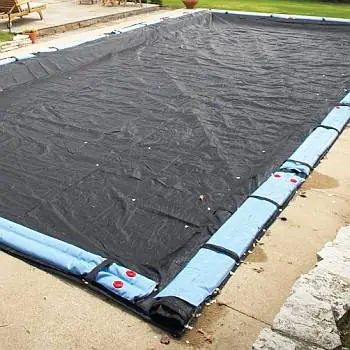Summer is approaching, and it's time to think about opening your swimming pool for the season. These steps should help you get your swimming pool open the right way.
- First, remove the water tubes and the pool cover. If there are leaves or other debris on the cover, use your leaf net to remove them. If there is any standing water on the cover then it needs to be removed. The best method for this is to use a cover pump. Note: if your cover has a hole in it, you will be pumping water out of the pool. This can lead to draining the pool, so be sure to watch for this.
- After removing the cover and tubes, be sure to clean them, let them dry, and store them away for the season.
- Re-insert any drain plugs you may have removed from your pump and filter. You will then need to add water, bringing the level up to its normal operating level.
- Remove any freeze plugs, Gizmos, or Air Pillows.
- Next, start your filter system up, being sure to prime the pump before starting the motor. Be sure to purge all the air from the plumbing and equipment. Warning: Air will be compressed during this procedure. Be sure to release any built up pressure before opening your filter, pump, or chemical feeder. Make sure that the valve is turned to the backwash position (for sand filters); this will ensure that any stagnated water left in your filter will not go into your pool.
- Check for any leaks.
- Assess the pool itself. Hopefully, you had a solid cover on and the water is as clear and blue as when you closed it. If not, you will want to remove any large debris with your leaf net, leaf rake, or leaf eater.
- Any dirt, sand, algae, or other small debris should be vacuumed.
- After cleaning the pool, it's time to check the water chemistry:
- DO NOT begin by throwing a bunch of chlorine or other chemicals into the water. Adding chlorine and other chemicals in certain circumstances can damage and/or stain your pool surface.
- Allow the water to circulate at least 8-12 hours, so that the water that was added has time to mix with the water in the pool.
- After that time, test the water thoroughly, then add the necessary chemicals in the proper sequence to balance the water chemistry. We suggest taking a water sample to your local pool professional to have it tested for pH, Total Alkalinity, Calcium Hardness, etc. Be sure to follow the procedure they describe to avoid damage to your pool.
- DO NOT begin by throwing a bunch of chlorine or other chemicals into the water. Adding chlorine and other chemicals in certain circumstances can damage and/or stain your pool surface.
- Install handrails, ladders, etc. making sure to inspect them for wear and damage. Car wax applied to stainless steel rails will help protect them from corrosion.
- Inspect the diving board. It should be free of stress cracks, and the surface should be non-skid. If the board has any stress cracks, it should be replaced. If the surface has been worn smooth, you can use a refinishing kit to correct this.
- Tile lines can be cleaned with baking soda and a sponge if you do not have any pool tile cleaner. Do not use household cleaners (especially abrasives) to clean the tile. You do not want to swim in these chemicals.
- GO SWIMMING!
Last Updated: 01/12/2026 01:55 AM - ID:5452


